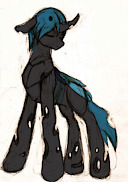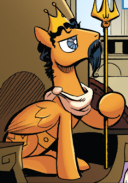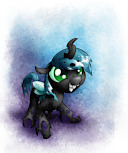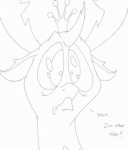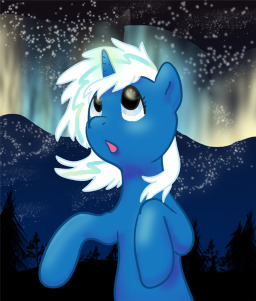
Chapter 6
The author's fear. A description of the Magnataurs, based on the author's knowledge gathered from Rangers. The author finds a migrating herd. A clash of titans.
While I was somewhat elated at the knowledge that I had finally reached the great northern continent, the Magnataur that had inadvertently saved me had given me a harsh reminder: I was in an untamed land, akin to the saurian plains of Concordia, and I was alone.

I would be remiss if I did not describe what I knew of Magnataurs here, as a description of their lifestyle should give the reader some idea of how harsh life is on Mustikk. However, what I know is only secondhoof accounts, gleaned from Rangers and other explorers, and frankly I do not plan on actually encountering any more of these massive primates if I can help it.
The notoriously long-lived magnataur are rumored to engage in cannibalism during times when food is scarce. Single males are known to control giant herds and produce sizable litters, but in the frigid, perilous wastes at the roof of the world, only the strongest and meanest survive. Despite their hostility to most races, the magnataur have become tolerant of the arctic tribes of kobolds (small reptilians related to dragons), who follow the herds for safety and mutual benefit during long hunts. Although the redoubtable magnataur lead solitary lives, adventurers who cross paths with them quickly learn that it would have been wiser to stay at a safe distance.
I have no doubt in my mind that, had the Magnataur sighted me in his rampage, I would have been crushed and eaten.

It was sunny after the fearful night I had experienced, and from the copse I stood in I observed the vast richness of the plains, such as they were. Green, dotted by small flowers and the occasional stand of pines stretched on into the distance.
One of the first examples of fauna which I observed was an impressive welcome to the threshold of Mustikk, but I suppose seeing a herd of mammoths would have the same effect on anyone who had never before observed the beasts.
Their domed heads raised high, bodies sloping downward from the hump on their shoulders, their impressive tusks curving before them, the herd stood and peacefully grazed, gripping tufts of grass with the broad ends of their trunks, pulling them out and stuffing them into their mouths. From the sight of a few calves I guessed that this was a herd of females, the males most likely living away from the group, much like the sapient elephants of Zebrica and Khaan.
I had expected them to be a deep brown color, but to my surprise, the fur of these creatures came in shades of not only brown, but also red, black, and even blonde!
As I observed the herd, a sudden movement nearby caught my attention, and i beheld an even more extraordinary beast. Though my description may seem ludicrous, I assure you I have no reason to exaggerate what my eyes beheld.
At first, i took it to be a massive flightless goose, or else some sort of long-necked pheasant. The beast towered over the mammoths, a small, blunt-billed head surveying its surroundings. It had a large stomach, a short, thick tail, and walked upon two thick, four-toed legs. Its entire body was covered in white feathers save for its grey, black-tipped beak. The creature moved to a nearby tree and stretched out a wing, and that was when I noticed its claws.
What claws! What arms! They could not have been less than eight or nine feet from the shoulder to the very tip of its middle digit! As I sat awestruck, the beast- some great, undocumented saurian no doubt- used the scythe-like appendage to strip away the outer bark of its chosen tree and began eating the soft inner bark.
The beast which Ice Crystal describes is an Arctotitan, one of the largest therizinosaurs known to zoology. During the time which she set out on her journey, living Therizinosaurs were not well known about outside of Concordia, Khaan, and Zebrica, and fossil examples were non-existent. The Arctotitan is unique for being found so far north, and has fully adapted to its environment with both thick, heat-retaining feathers and an insulating layer of fat- Professor Grant, head of Paleontology and Saurian Zoology at the Canterlot Museum
As I continued watching, I suddenly caught sight of a large shape in another stand of pines. With no sound other than that of a few snapping branches, it charged out and sent the mammoths into a panic.
This beast was no less extraordinary than the white mountain of feathers, but more ferocious by far. It could not have been less than 40 feet long, and stood 12 feet tall, a pair of gleaming saber-like canines hanging from its enormous jaws.
I recognized the beast... but not exactly. I had once seen a travelling circus which had displayed the taxidermied corpse of a beast from Concordia known as a Bone Eater. It was a fearsome-looking sight, roughly the same size as the creature before me. However, it lacked this monster's saber teeth, and while the Bone Eater was covered in brick red and dull gold scales, this creature was covered with grey, tan, and white feathers, patterned with dark spots. And I do mean covered, as even the beast's feet were feathered.
It ignored the mammoths, setting its sight on the large-clawed beast. Rather than running, the creature honked like a massive goose, arms spread wide.
The saber-toothed saurian circled the herbivore. I noticed a few scars on its muzzle, no doubt caused long ago by a similar quarry to that which it now hunted. The beast probably subsisted on the massive creatures as a main part of its diet, along with mammoths and who knows what other large creatures found here.
The carnivore tested the boundaries of its chosen prey a few times, narrowly avoiding the claws at least twice... and suddenly, on a third attempted strike, the beast dodged again, circling around, thick neck pushing the blunt-snouted face toward the prey's unprotected flank, and the saber teeth sliced past the thick layers of feathers and blubber to the steaming muscle below, inflicting a serious wound
The herbivore screamed in pain and fled, while the predator followed along at what I can only describe as a leisurely pace, occasionally making dashes towards it in order to inflict more damage before retreating once again. I saw its method instantly- it would simply let its prey bleed out, and then eat once it had expired.
There is no doubt that the beast described here is a Sabre Tyrant, one of the most feared predators of the north. Smilotyrannus imperator, as well as other saber-toothed tyrannosaurs, is a leftover from the Ice Age, a massive predator of mammoths, arctic ceratopsians, and the Arctotitan. The bleed to death tactic noted by Ice Crystal is typical of this species.
The Bone Eater of Concordia is a relative of the Sabre Tyrant, and is just as specialized. Hyaenosaurus osseophagus is a brutal predator as well as an expert scavenger, its thick arms allowing it to grapple onto a target with a vice grip, immensely powerful jaws capable of crushing bone and ankylosaur armor with ease, and a cast-iron stomach which digests even the most poisonous and rotten meat without much effect.
The specimen which Ice Crystal observed in the travelling circus was donated to the Canterlot Museum 300 years ago, and "Big Red" continues to be one of the most impressive exhibits to date.- Professor Grant, head of Paleontology and Saurian Zoology at the Canterlot Museum
I had no true desire to observe this, and quietly moved on.
- Viewing 1 - 0 of 0
- Viewing 1 - 0 of 0



